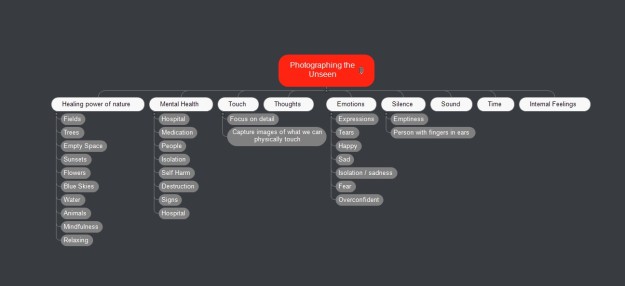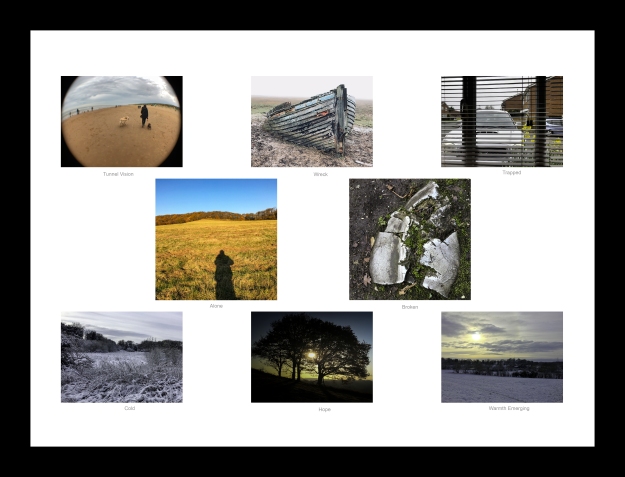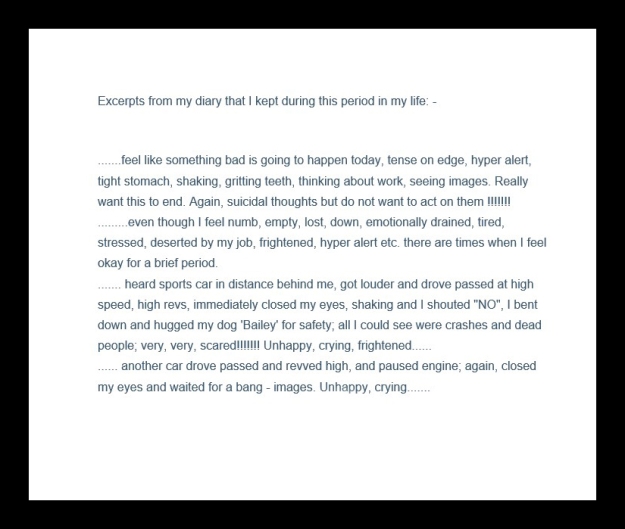The brief for assignment two was to choose one out of two suggested assignments:
- Photographing the unseen
- Using props.
The assignment I have chosen to do is :
Photographing the Unseen.
I choose this subject following completing Project 3 in particular the work of Dewald Botha and his project Ring Road as I could relate to what he was describing to my own condition of Post Traumatic Stress Disorder; especially at the height of my illness.
- Reflect in log what kinds of subjects might be seen as in-photographable?
- How might you go about portraying them using photography?
Below is a mind map for the above, upon reflection all the subheadings merge into one.

Fig. 1. Mind map for the start of Assignment 2
Mental Health – The Healing Power of Nature.
- List a few examples of things you’re experiencing now or have recently been thinking about.
Anxious, Tired, Thankful still alive, Broken, Happy,
- Make a list of at least seven ideas, trying to keep things you have a personal interest in or curiosity about.
- Now implement one of your ideas. Aim for a tightly edited and visually consistent series of 7 – 10 images.
Every time I sat down to think of ideas for this assignment, despite a conscious effort to open my mind, I kept returning to the same idea that I thought of originally; Mental Health – The Healing Power of Mother Nature.
After creating the series entitled Mental Health – The Healing Power of Nature , following researching Narrative, I decided that the series would be better suited to the title of:
Mental Health – PTSD, Photography and Nature.
During research I managed to find a website entitled ‘Exploring Mental Health in Photography Through Interviews with Artists’ – http://fragmentary.org/.
This web site was established in 2015 by Daniel Regan and explores via photography projects / artworks, complex issues surrounding Mental Health.
The images are very powerful and portray the feelings that the artists themselves are subjected to.
If you look at the work of Luck Bentham (http://fragmentary.org/lucy-bentham/) she describes her work as ‘conceptually driven surrounding personal themes’.
One series shows four images of a woman in a bath; one is where the woman is lying in a pool of very dirty water, there is a scum line around the bath suggesting that she has been in there a long time; however she is still dirty. Is this because she does not want to get out, as in the water she is safe? water soothes the soul and relaxes you. She appears to be staring into space with a blank expression on her face, is this how she feels? Why is she so dirty? has something happened to her and she is trying to wash it away but it will not go? The mood has been captured by using black and white instead of colour and replicates the gloomy darker side of life.
From personal experience I know how soothing water can be, when your in a bath, submerged you feel protected from your demons, in a shower holding yourself tight, feeling the water hitting your head and running down, giving you a sense of calm and at peace; however, you still do not want to get out and face reality; that ‘Black Dog’ looming in the shadows.
The two extracts I found very useful when conducting this assignment and and remained in the forefront throughout.
(Short 2011:70) states “Contemplate the photograph from the perspective of the intention and look at the photograph in a way that examines what is exactly there and how it is presented, as that is what the audience will see and respond to, If we make the statement ‘I wish to convey a sense of ‘x’ in my photograph, then it would be helpful to clarify in words what ‘x’ is and then examine the photograph asking ourselves if each component is contributing to the conveying of ‘x’.”
“Perhaps the most challenging, yet rewarding element in self-expression is the ability for artists to peel back the layers from within and convey intimate details about their lives, perspectives and experiences in the world. Whether an artist expresses these attributes via vast landscapes, minute details in ones life or happenstance findings, the result conveys an authentic universality that connects every viewer on some level.” Personal Narrative (2016)
Statement of Intent.
My intention for this assignment is “to convey some of the effects that a mental health condition, namely, Post Traumatic Stress Disorder (PTSD) has on a person, in particular, myself.”
Background
In April 2015 after 25 years experience in West Midlands Police, most of which was dealing with fatalities on the roads, I was signed off work by my Doctor who, along with a Psychiatrist, diagnosed me with Post Traumatic Stress Disorder (PTSD).
My life as my family and I knew it, ceased to exist.
I lost interest in all my hobbies, including photography and became a recluse: a scared, hypersensitive, argumentative, wreck; who could not sleep and regularly suffered from panic attacks and flashbacks detailing certain scenes of fatalities that I had attended.
However, despite not been able to go out or walk near to roads as the sound of a car’s engine triggering flashbacks, I had a dog who needed to be exercised.
I found myself walking along the canal at the rear of our house and into mother nature herself; this is where I sought sanctuary; my safe place. It is also where I started to explore the therapeutic powers of photography using my IPhone.
In 2017 I was granted ill health retirement and with the assistance of the National Health Service, my family and close friends, three years on, I now live a life that I can be comfortable with.
The series below has been captured using my IPhone representing the particular era in my life, coupled with the images and text I have attempted to show my inner feelings during this traumatic time.
By using images of nature I wanted not only to replicate my feelings, but also incorporate some of the places that I went to for sanctuary, mother nature herself has hidden healing powers and it is not until we need them do we appreciate her.
(309 words).
Mental Health – PTSD, Photography and Nature.

Fig. 2 – Assignment 2 Hanging Plan

Fig. 3 – Excerpts from my diary.
List of References.
Personal Narrative (2016) https://photoplacegallery.com/personal-narrative/ (accessed 19 April 2018)
Short, M (2011) Context and Narrative, Switzerland: AVA Publishing.
List of Illustrations.
Figure 1. Cope. P (2018) Mind Map for the Start of Assignment 2.
Figure 2. Cope. P (2018) Assignment 2 Hanging Plan [Photograph] In Possession of Cope. P. Stourbridge.
Figure 3. Cope. P (2018) Excerpts from my Diary.
List of Bibliography
https://digital-photography-school.com/10-ideas-for-photographing-nature-in-your-backyard/ (accessed 13 April 2018)
https://www.meetup.com/Paulding-Photography-Club/events/239521825/
https://photographylife.com/the-healing-power-of-photography (Accessed 13 April 2018)
https://www.steveparish-natureconnect.com.au/healing-power-of-nature/ (accessed 13 April 2018)
http://www.johnmunnophotography.com/therapeutic-photography-and-healing-photography-art (accessed 13 April 2018)
http://www.sallywaterman.com/projects.php
http://thefiendish.com/2009/04/ela-gora-personal-narratives-through-photography/
https://webdesign.tutsplus.com/articles/tips-to-help-you-properly-mix-text-with-imagery–cms-21575
http://www.photopedagogy.com/photo-literacy.html
Reflection.
Demonstration of Technical and Visual Skills.
Coursework.
In exercise 2 I have shown skills in presentation by not just relying on images to portray the message but using a slideshow and audio.
Assignment.
In keeping this assignment true to how my images were taken at that time in my life, I have re-used my IPhone and in doing so I have drawn upon the experiences I learned following partaking in an online IPhone photography course.
The skills I already have in photography have been transferred, i.e. composition, take Figure 7 – ‘Alone’; the horizon has been placed on the top third of the image allowing the vast empty grassland to be revealed, dictating space and by photographing with the sun behind me projecting my reflection onto this area, shows I was there alone.
In Figure 10 – Hope, I have singled out this particular tree because it is one that I often sit underneath and think / reflect. I photographed into the sun to create the effect of a silhouetted shrine and by capturing the sun in the middle of it creates the effect of ‘enlightenment / hope’.
In Figure 4 – Tunnel Vision, I took the image with a fish eye lens mounted onto my IPhone to create the effect of tunnel and then in post processing I have added a blur effect leaving the focus clear on my family in front of me to over emphasise the feeling of ‘tunnel vision’.
Quality of Outcome.
Coursework.
I have shown that I have understood the concept of anchoring and relaying by replacing words / captions that have been used on images for ones of my own and altered the meaning of it.
Assignment.
This assignment has been based on my own personal experiences of some of the effects that a Mental Health condition, namely, Post Traumatic Stress has on you, and for myself by using photography alongside ‘mother nature’ shows how this combination can have healing powers.
As I have an understanding of the effects of PTSD, all my images represent the feelings I had and by incorporating text underneath each image bolsters the meaning. I have deliberately kept the text small and reduced its opacity so not to distract away from the image and made sure that the first thing you see is the image itself.
By presenting the assignment as a A3 size hanging plan with excerpts from my diary that was written at the time next to it, adds to the context and completes the presentation.
Demonstration of Creativity.
Coursework.
From my last assignment and my first assessment it was pointed out to me that I needed to be more creative, take risks, so I believe this time I have.
For Exercise 2 instead of just showing images to portray a poem, I have used a slideshow with audio overlaid. To do this I had research how to create a slideshow and then how to incorporate the music. I then had to work out to get the slideshow from Lightroom to my google drive and make it play automatically.
For the research point exercise I have show analytical thinking and formed my own opinion of what the two projects were trying to say.
Assignment.
From the outset I knew that this assignment was going to be around the subject of Mental Health, in particular, my mental health.
In order to organise my thoughts and ideas I have utilised the use of mind mapping and from this I have developed my idea.
To incorporate all the aspects, i.e Mental Health, Photography and Nature, I wanted to keep the concept simple but effective in its output; I could have chose to dramatize the images to represent my feelings, this may have had the desired effect but I wanted to be true to my journey at the time and show how with nature and photography assisted me to get to the point in my life that I am now at; studying for a Degree in Photography.
If we look at the images as a series, I believe that they all connect together and work well in representing the concept; I also believe that by incorporating excerpts from my diary written at the time of my illness increases the dramatic effect and leaves the viewer in no doubt what they are looking at.
Context.
Coursework.
I have shown good analytical thinking after reading ‘The Country Doctor and The Dad Project’ for Project 1 and upon reflection I have shown analytical thinking by describing the difference between the two.
I believe that my personal voice at the moment is starting to shine through around the subject of Nature and Mental Health.
In Project 3 ‘Photographing the Unseen’ after reading all three projects the project that resonated with me the most was Botha’s project, ‘Ring Road’. The reason for this was after reflection I could myself in his context, the lost, lonely person using photography as therapy. This resulted in me searching back through my archives and including some images that I had taken around the time to represent ‘My Ring Road’.
Assignment.
For this assignment I made a concerted effort to engage with the forum and posted my ideas for my peers to comment on. After reflection I came up with the concept for my presentation, altering and removing a couple of images along the way.
Reading ‘Context and Narrative’ by Maria Short, ‘Making Photographs’ by Mike Simmons and ‘Behind the Image’ by Anna Fox and Natasha Caruana have definitely assisted me for this assignment and will also do so in the future.
In my assignment I have attempted to introduce sections from both ‘The Dad Project’ and ‘The Country Doctor’. I have included little written context with the images allowing the viewers’ imagination to develop, but by including captions underneath in small writing that is barely visible, the viewer noticing this will be steered back along my intended path.
With regards to including separate written excerpts from a diary that was written contemporaneously during my period of unwell, this reinforces my original concept and is in keeping of a personal response like ‘The Dad Project’.
I am currently reading the book ‘Understanding a Photograph’ by John Berger which I will reflect upon later.
The research for this assignment will benefit me going forward for assignment three.
I have continued to reflect on my progress within my learning log on a weekly basis but may restructure the layout of it.
I am aware that I need to be more creative in my ideas which I hope will develop with more research and reading; however, this assignment I believe that the simplistic approach undertaken is in keeping with my current vision of Contemporary Landscape photography.
Overall.
I have really enjoyed this section and feel that I am now starting to look at photographs in a different light.
I am starting to analyse them in greater detail; what can I see, what do I like about it, why am I drawn to it, what is the artist trying to communicate with us about his photograph, what style is it in etc etc.
This I believe is also reflecting in my work and how I approach it in a positive way.
I am aware that I still have a long way to go and a lot more to learn but by having a passion in your subject drives you
I particularly enjoyed and got a lot of benefit out of posting my images for my peers to criticise and did not feel isolated as before.
I need to continue to engage with my peers and also conduct my own studies to enhance my knowledge.



















